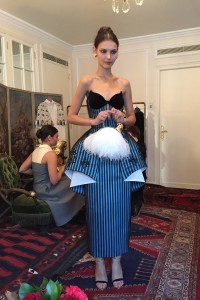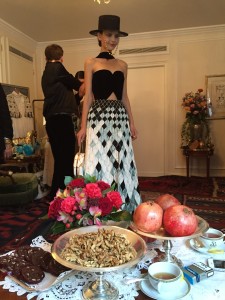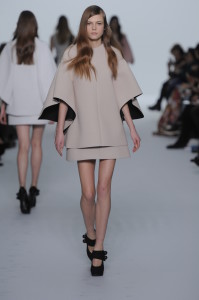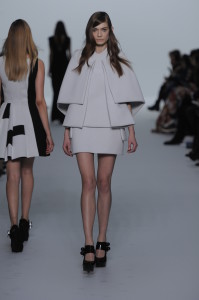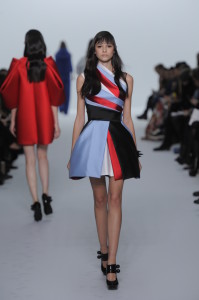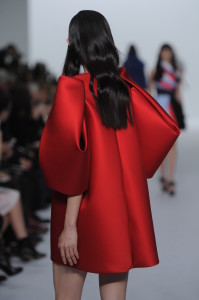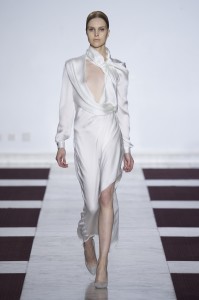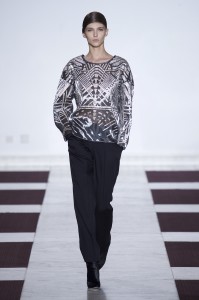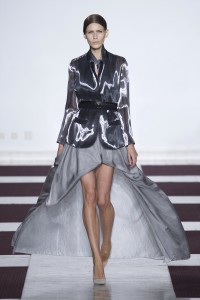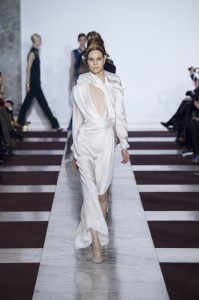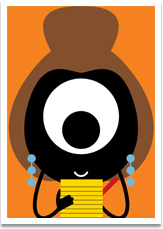Ulyana Sergeenko, Dice Kayak, Yiqing Yin, and a Very Topical Fashion Exhibition
![]() When a Paris museum dedicated to the history of immigration opened eight years ago, no one could have predicted the ways in which its subject would become more relevant and more contentious.
When a Paris museum dedicated to the history of immigration opened eight years ago, no one could have predicted the ways in which its subject would become more relevant and more contentious.
Not long after the recent extremist attacks in Paris, I arrived at the Museum of the History of Immigration, at the aptly named Porte Dorée, or Golden Gate, in the 12th arrondissement. What could fashion have to do with this touchy subject of French identity and its economic, social and cultural diversity?
But as soon as I walked into the exhibition, Fashion Mix, I was transfixed by a map of the world. It was traced with arrow-strait lines that showed the trajectory of a mass of designers from outside of France – some famous from the past such as Cristobal Balenciaga, Elsa Schiaparelli and Charles Frederick Worth, others more recent or contemporary, from Azzedine Alaïa through to Alexander McQueen and Junya Watanabe.
The exhibition, curated by Olivier Saillard, director of the Palais Galliera, lives up to its title, placing the grand gestures of John Galliano or Vivienne Westwood beside a Lucile dress from the Twenties. Details, letters, drawings and information about the best-known designers are given in a mini-cabinet at the front. The show is a great way of documenting fashion.
Olivier Saillard divides these fashion ‘immigrants’ into different countries of origin, such as Japan or Russia, although I was not entirely comfortable with the groupings. Surely a distinction should have been made between designers who left their home countries and settled in Paris, frequently ‘Frenchifying’ their names, such as the Egyptian Jean Dessès, and those many designers, such as Rei Kawakubo of Comme des Garçons, who show in Paris but do not live there.
Equally, the Russian contingent which appeared in the 1920s included designers who were often aristocrats fleeing the revolution, and who used their sewing skills to keep afloat. These were genuine immigrants, rather than designers looking for fashion-world consecration in Paris.
Yet the exhibition includes some touching stories that show how challenging it could be to travel in the early days, before the availability of easy and affordable flights. In a video interview displayed in the show, Yohji Yamamoto talks about his train journey from Japan, via Siberia, through Finland and Denmark and finally to Paris, where he said he “felt I had come home.”
For fashion lovers, the exhibition is interesting in that it shows even recent designers, like Helmut Lang, who are now part of history. And even though Saillard hardly mentions the inflammatory ‘immigration’ word, we get the message: the Paris stew of high style does not have purely French ingredients.
And, indeed, this summer couture season has witnessed collections from designers whose origins are not French. Here are some of the ones included in the current fashion mix.
Ulyana Sergeenko: Georgia on Her Mind
Everything about Ulyana Sergeenko seems like a Russian fairy tale. She manages to blend folklore and costume, while transforming them into compelling clothes. This season, the focus of her collection was Georgia and Armenia, inspired by the Caucasus background of her husband’s father.
This designer’s skill is to tell tales through clothes that are simple in shape but poetic in decoration. I ran my hand over diamond patterns created with pleats and hand stitching; or embroidery of spidery flowers over bold stripes. Some pieces used Georgian calligraphy, and there is a sense in Ulyana’s work that she is preserving techniques and traditions that might otherwise be lost.
Add furry bags in the shape of chickens, and romantic hats in collaboration with milliner Stephen Jones, and it shows that this is not a history lesson but an aesthetic vision.
Dice Kayak: Dollhouse Visions
London’s Victoria and Albert Museum gave the 2013 Jameel Prize for contemporary design inspired by Islamic traditions to Turkish sisters Ece and Ayşe Ege, who make up the Paris-based label Dice Kayak.
But anyone thinking that their summer couture collection would be about Islamic tile patterns, or a riff on the contentious subject of headscarves, would be wrong.
The Dice Kayek inspiration was dolls – not the sweet childish type – more the artistic creations of Hans Bellmer or Louise Bourgeois. The result was not so much the fetishist’s view of dolls, often expressed in art, but rather a mathematical vision of clothes drawn on a geometric pattern
On the runway, the vision was of sculpted dresses that followed the body’s curves; others had flute-shaped sleeves or gathered cape-like effects from the shoulders; while some graphic lines juxtaposed bright shades of red and blue, black and white.
The programme notes described this, poetically, as “spinning-top dresses with mille-feuille, multi-coloured silk.” This makes it sound more like a doll’s wardrobe. But the collection seemed streamlined and modern for real women.
Yiqing Yin: Reality Check
Having fled with her family at age four from her native China, then living in France in a culture she had to learn to understand, it is not surprising that Yiqing Yin has been fascinated by mutation.
I have seen her collections when fabrics, animal or vegetable, all seemed to have a fragile existence, before they morphed into different entities.
But this season, the designer, in her own words, “made a step aside”, after having explored her “dream-like world”.
Focusing on the body shape, but always seeming to leave space between torso and clothes, Yiqing Yin sent out a graceful collection, tracing angles and curves with the harmony that does justice to her French training – and her Asian heritage.








